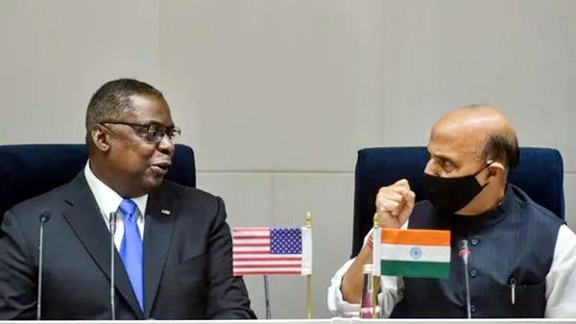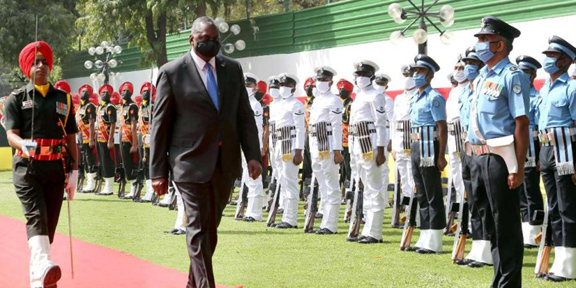

“It may be pointed out that Lloyd Austin is the Secretary of Defense, and within the US set up, matters such as human rights and democracy overseas do not come under his domain. However, while responding to a question during a media briefing, Austin said that he had raised issues of human rights of the country’s minorities with members of the Indian cabinet as “partners need to be able to have those kinds of discussions”. Asked specifically if he had raised the violation of human rights of India’s minorities as the first member of the Biden administration to meet Prime Minister Narendra Modi, Austin replied that he “did not have an opportunity to talk with him about that issue during their meeting,” adding: “Having said that, I did have a conversation with other members of the cabinet on this issue. I think we have to remember that India is our partner and a partner whose partnership we value, and I think partners need to be able to have those kinds of discussions. And certainly, we feel comfortable in doing that, and you can have those discussions in a very meaningful way and still make progress,” Austin said.”
In diplomacy, timing matters a lot, and the timing of the visit was very significant. It came on the heels of the US-China acrimonious talks in Alaska which have been described by the BBC as’ an unusually undiplomatic sparring match’. Moreover, it was just a week after the Quad summit had been convened by President Biden, and which PM Modi had attended.

Gen. (Retd) Llyod Austin, the US Secretary of Defense, visited India from March 19-21. As would be expected, the Indian Government rolled out the red carpet and gave the visit a very high degree of importance. He met Prime Minister Modi, Defense Minister Raj Nath Singh, National Security Adviser AjitDoval and External Affairs Minister S. Jaishankar. What are the key takeaways from this visit? What are the markers and signposts which can help understand where the relationship is headed?
In diplomacy, timing matters a lot, and the timing of the visit was very significant. It came on the heels of the US-China acrimonious talks in Alaska which have been described by the BBC as’ an unusually undiplomatic sparring match’. Moreover, it was just a week after the Quad summit had been convened by President Biden, and which PM Modi had attended.
It was also the first overseas visit by a senior member of the Biden Administration, and it came right after his own visits to Japan and Korea–both key allies of the US. Clearly, the visit was aimed at strengthening the strategic partnership between India and the US.
US Defense Secretary Austin had stated unequivocally during his Senate confirmation hearing on January 19 that “If confirmed, my overarching objective for our defense relationship with India would be to continue elevating the partnership”. The fact that India figured in the list of countries during his first visit abroad shows that he is keen to translate his commitment into action. Working closely with India has become an important aspect of US foreign policy, and US policy planners envision that it is in their country’s interest to augment the bilateral proximity in the present global scenario.
The importance attached by President Biden to working with India was emphasized by his Administration from the very start. Just two days after the Presidential inauguration, Jen Psaki, the White House Press Secretary said at a news briefing that “President Biden, of course has visited India many times, respects and values the long, bipartisan, successful relationship between leaders in India and the United States. He looks forward to a continuation of that.” Again, on March 9, Psaki said that Biden has made the Quad summit on Friday March 12 one of his earliest multilateral engagements, and that it shows the importance which the US is giving to closer cooperation with its allies in the Indo-Pacific region.” Thus, the White House had sent clear signals that it would seek to strengthen Indo-US relations.
Of course, China’s territorial and economic expansionism is serving as a catalyst in this regard. Early on, there were signs that the Biden administration saw the US-China relationship in less hostile terms as compared to the Trump Administration. However, as the days rolled by, there was a perceptible hardening of the Biden Administration’s attitude towards China. Slowly, it became more upfront in being publicly critical of Beijing. When he delivered a virtual address at the Munich Security Conference on 19th February, Biden said “We have to push back against the Chinese government’s abuses and coercion that undercut the foundations of the international economic system”. In his blunt opening statement at the Alaska meeting on 18th March, Secretary of State Antony Blinken said the US side would “discuss our deep concerns about actions by China, including in Xinjiang, Hong Kong, Taiwan, cyber-attacks on the United States, economic coercion of our allies”, adding “each of these actions threatens the rules-based order that maintains global stability.”
The US approach was also spelt out recently by Blinken and Austin in their joint op-ed in the Washington Post on 15th March–just three days before the Alaska meeting and Austin’s visit to India. They wrote:” The United States is now making a big push to revitalize our ties with friends and partners — both in one-to-one relationships and in multilateral institutions — and to recommit to our shared goals, values and responsibilities.” They also wrote: “The Indo-Pacific region is increasingly the center of global geopolitics. It is home to billions of the world’s people, several established and rising powers, and five of America’s treaty allies. Plus, a great deal of the world’s trade travels through its sea lanes It is strongly in our interests for the Indo-Pacific region to be free and open, anchored by respect for human rights, democracy and the rule of law.”
About the threat from China, they wrote:” Not all countries share this vision. Some seek to challenge the international order — that is, the rules, values and institutions that reduce conflict and make cooperation possible among nations. As countries in the region and beyond know, China in particular is all too willing to use coercion to get its way. Here again, we see how working with our allies is critical. Our combined power makes us stronger when we must push back against China’s aggression and threats. Together, we will hold China accountable when it abuses human rights in Xinjiang and Tibet, systematically erodes autonomy in Hong Kong, undercuts democracy in Taiwan or asserts maritime claims in the South China Sea that violate international law. If we don’t act decisively and lead, Beijing will.” Underscoring the importance of working with like-minded nations, they wrote that “it’s the most effective way to meet the challenges we face today, few of which can be solved by us acting alone.”
In this context, working closely with India makes good sense to US policy makers. After Austin’s meetings with PM Modi and NSA Doval, the US Embassy said ““Both sides exchanged perspectives on shared challenges confronting the region and committed to further strengthen their broad ranging and robust defense cooperation.” On its part, India reciprocated the sentiment. PM Modi tweeted after the meeting ““India and the U.S. are committed to our strategic partnership that is a force for global good.” The Ministry of External Affairs also said in a statement ““The Prime Minister welcomed the warm and close relationship between the two countries, which is rooted in shared values of democracy, pluralism and commitment to a rules-based order.” In this context, working closely with India becomes more intrinsic to US policy formulation.
At the same time, another aspect of Defense Secretary Austin’s visit should not be overlooked. The Pentagon sees India as a potential purchaser of advanced weapons systems and this makes it even more necessary for Biden to seek a closer relationship with the Indian political establishment. The on-going India-China standoff at the LAC continues to be seen by the US as a great opportunity to sell weapons and other defense-related items which India needs to acquire at such a difficult time.
Both countries have increased their defense partnership in recent years and signed four key foundational defense pacts. The General Security of Military Information Agreement (GSOMIA) was signed by the government of Atal Bihari Vajpayee back in 2002. It aims to protect the military information shared by the US. The Logistics Exchange Memorandum of Agreement (LEMOA) was signed a full 14 years later in 2016, and it aims to provide mutual logistics support around the world. The Communication Compatibility and Security Agreement (COMCASA) was signed in 2018, and it aims to facilitate communication between the weapons platforms of the two armed forces. Finally, the Basic Exchange and Cooperation Agreement was signed at the Indo-US 2+2 meeting in October 2020 and it largely pertains to geospatial intelligence, sharing information on maps and satellite images for defense. BECA will provide Indian military systems with a high-quality GPS to navigate and missiles with real-time intelligence to precisely target the adversary. It will also give access to topographical and aeronautical data and products that will aid navigation and targeting.
In this context, it may be noted that India has substantially increased its acquisition of US defense equipment. Indian forces are operating US-sourced platforms such as P-8s, C-130Js, C-17s, AH-64s, CH-47s, Precision Guided-Excalibur Munitions, and M777 howitzers. In February, India agreed to acquire Apache and MH-60R multi-mission helicopters worth $3.1 billion, and is considering other US systems. A deal for 30 armed drones, 10 each for the army, air force, and navy, estimated at $3 billion, is close to being approved by the Indian defense ministry. In November 2020, the Indian Navy acquired two Sea Guardian unarmed drones from the U.S. on a one-year lease. India has plans also to buy six additional P-8I long range maritime patrol aircraft in addition to the 12 already contracted. During the Trump Administration, amidst all the din about the US standing alongside India to ward off the Chinese threat, there was an unmistakable sales pitch that was clear as daylight. US media reports made no secret of the fact that during the 2+2 dialogue in October 2020, Mike Pompeo and Mark Esper had tried to push India to purchase MQ-9 Reaper drones. From the beginning, Trump had made arms sales a central component of his foreign policy.
It cannot be doubted that the Biden Administration will also push for arms-sales to India, and Defense Secretary Austin undoubtedly saw this as a priority item on his agenda during his visit.
However, some irritants in the Indo-US bilateral relationship cannot be overlooked. Prior to his visit to India, US Senate Foreign Relations Committee chair Bob Menendez had written a letter to him asking him to raise concerns about India “trending away” from shared democratic values, including the Indian government’s handling of the farmers’ protest and a crackdown on journalists and critics. “In meetings with Indian counterparts during your upcoming visit, I strongly encourage you to make clear that in all areas, including security cooperation, the US-India partnership must rest on adherence to democratic values,” Menendez said in his letter.
In his capacity as Chairman of the Senate Foreign Relations Committee, Menendez plays a key role in influencing the country’s foreign policy and national security. Among his predecessors include President Joe Biden, who occupied this position during former president George Bush’s administration and former secretary of state John Kerry. It may be pointed out that Lloyd Austin is the Secretary of Defense, and within the US set up, matters such as human rights and democracy overseas do not come under his domain. However, while responding to a question during a media briefing, Austin said that he had raised issues of human rights of the country’s minorities with members of the Indian cabinet as “partners need to be able to have those kinds of discussions”. Asked specifically if he had raised the violation of human rights of India’s minorities as the first member of the Biden administration to meet Prime Minister Narendra Modi, Austin replied that he “did not have an opportunity to talk with him about that issue during their meeting,” adding: “Having said that, I did have a conversation with other members of the cabinet on this issue. I think we have to remember that India is our partner and a partner whose partnership we value, and I think partners need to be able to have those kinds of discussions. And certainly, we feel comfortable in doing that, and you can have those discussions in a very meaningful way and still make progress,” Austin said.
In this regard, the thinking of some key players in the Biden Administration is no secret. In 2019, soon after the Centre stripped Jammu and Kashmir of special status under Article 370 and split it into two Union Territories, Kamala Harris did not mince words. “We have to remind Kashmiris they are not alone in the world,” she said. “We are keeping a track on the situation. There is a need to intervene if the situation demands.” Again, in the Biden campaign’s agenda for Muslim Americans, India’s National Register of Citizens and Kashmir featured in the list of threats to Muslim populations across the world. “In Kashmir, the Indian government should take all necessary steps to restore rights for all the people of Kashmir,” said the campaign agenda. “Restrictions on dissent, such as preventing peaceful protests or shutting or slowing down the Internet, weaken democracy.”
Freedom House, a US-based, US-funded Non-Governmental Organization said in its recent report ‘Democracy under Siege’ that Civil liberties in India have been in decline since PM Narendra Modi came to power in 2014. The report downgraded India’s rating to ‘partly free’. Trump had maintained a tactical silence in regard to India’s Citizenship Amendment Act and the human rights situation in Jammu and Kashmir. While the Biden Administration may also find it necessary to maintain a similar tactical silence on these internal matters of India, during closed-door meetings with the Indian side, such reports are likely to be cited as instances of ‘independent’ studies calling on India to undertake a course-correction. Something of this nature appears to have been done by Austin. On their part, senior Indian officials have said that human rights and values were discussed as shared strengths of the two countries. However, this irritant is likely to keep raising its head from time to time.
There is another and perhaps more serious danger to the US-India relationship lurking on the scene and it relates to CAATSA (Combating America’s Adversaries Through Sanctions Act). On India’s reported plan to purchase the Russian S-400 missile defense system, Senator Menendez said in his letter to Defense Secretary Austin that if India chooses to go forward with its purchase, that act will clearly constitute a sanctionable transaction with the Russian defense sector under provisions of CAATSA. “I recognize that India is not a US treaty ally and has historical ties with the Soviet and Russian militaries. However, if India chooses to go forward with its purchase of the S-400, that act will clearly constitute a significant and therefore sanctionable, transaction with the Russian defense sector under Section 231 of CAATSA,” Menendez wrote. “It will also limit India’s ability to work with the US on the development and procurement of sensitive military technology. I expect you to make all of these challenges clear in conversations with your Indian counterparts,” he said.
Defense Secretary Lloyd Austin did raise the issue of India’s planned acquisition of the S-400 air defense system from Russia and stressed that allies and partners should avoid “any kind of acquisitions that will trigger sanctions”.
It may be recalled that In October 2018, India had signed a USD 5 billion deal with Russia to buy five units of the S-400 air defense missile systems, despite a warning from the then Trump administration that going ahead with the contract may invite US sanctions. In 2019, India made the first tranche of payment of around USD 800 million to Russia for the missile systems which are expected to be delivered later this year.
The United States had in January 2021 imposed sanctions on Turkey, a NATO ally for purchasing S-400 surface-to-air missile systems from Russia. However, it had done so only after Turkey took the delivery of the first shipment. Briefing the media, Austin said that the question of CAATSA or sanctions against India is not on the table as India has not taken delivery of the system. He, however, did not elaborate on what will happen when India will take delivery of the system later this year. Summing up, one cannot ignore these potential roadblocks for the Indo-US relationship. They cannot be wished away because they are very much real. There is a great deal of affinity being shown by US policy makers towards India, but it may lessen considerably if they can sort out their difficulties on trade-related issues with China. The signposts and markers in the unfolding scenario will have to be watched closely to understand where the relationship is heading.
(The author is a retired Indian diplomat. He can be reached atprabhu_dayal70@hotmail.com )
(Courtesy OPOYI)





Be the first to comment